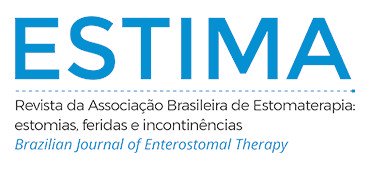Análise retrospectiva da aplicação da escala de Braden Q em terapia intensiva pediátrica
Resumo
Objetivo: caracterizar o perfil dos pacientes que desenvolveram lesão por pressão e analisar os escores retrospectivos obtidos na aplicação da Escala de Braden Q em terapia intensiva pediátrica. Método: estudo de coorte retrospectivo com análise de dados secundários de 34 prontuários eletrônicos de pacientes internados em terapia intensiva pediátrica. Resultados: da análise dos escores obtidos com aplicação da Escala de Braden Q, foram identificados seis registros de lesão por pressão; a média de idade foi de 8,1 anos; 66,6% do sexo masculino; média de 41 dias de internação; principais diagnósticos estão relacionados a doenças do sistema respiratório, cardíaco e neurológico; todos utilizaram suporte de ventilação mecânica invasiva e apresentaram prescrição de jejum e uso de sonda nasogástrica. Conclusão: o perfil clínico está correlacionado ao sexo masculino, à maior frequência de doenças respiratórias com necessidade de ventilação mecânica, ao uso de drogas vasoativas, vasopressoras e sedativas, e à sonda como via de administração de dieta. Todos apresentaram escores de alto risco para desenvolvimento de lesão por pressão.
Downloads
Métricas
Referências
Salvador TC, Cedraz AM. Child hospitalization: child living from graphical representations. Rev. Enfermagem UFPE on line. 2017;11(1) [cited 2020 Jun 18]. Available from: https://periodicos.ufpe.br/revistas/revistaenfermagem/article/view/11916/14407.
Gomes GLL, Fernandes MGM, Nóbrega MML. Hospitalization anxiety in children: conceptual analysis. Rev. Brasileira de Enfermagem- REBEN. 2016;69(5) [cited 2020 Jun 18]. Available from: http://dx.doi.org/10.1590/0034-7167-2015-0116.
Santos GS, Pieszak GM, Gomes GC, Biazus CB, Silva SO. Contributions of Better Childhood for growth and child development in family perception. Rev. Fun Care on line. 2019;11(1) [cited 2020 Jun 18]. Available from: http://dx.doi.org/10.9789/2175-5361.2019.v11i1.67-73.
Matozinhos FP, Velasquez-Melendez G, Tiensoli SD, Moreira AD, Gomes FSL. Factors associated with the incidence of pressure ulcer during hospital stay. Rev. Esc. Enferm. USP. [Internet]. 2017;51 [cited 2020 Jun 22]. Available from: https://doi.org/10.1590/s1980-220x2016015803223.
Bergquist-Beringer S, Gajewski B, Dunton N, Klaus S. The reliability of the national database of nursing quality indicators pressure ulcer indicator: a triangulation approach. J Nurs Care Qual. 2011;26(4) [cited 2020 Jun 22]. Available from: https://doi.org/10.1097/NCQ.0b013e3182169452.
Vocci MC, Fontes CMB, Abbade LPF. Pressure Injury in the Pediatric Population: Cohort Study Using the Braden Q Scale. Adv Skin Wound Care. 2018;31(10) [cited 2020 Mai 28]. Available from: https://doi.org/10.1097/01.ASW.0000542529.94557.0a.
Kiss EA, Heiler M. Pediatric skin integrity practice guideline for institutional use: a quality improvement project. J Pediatr Nurs. 2014;29(4) [cited 2020 Jun 22]. Available from: https://doi.org/10.1016/j.pedn.2014.01.012.
Tume, LN, Siner S, Scott E, Lane S. The prognostic ability of early braden Q scores in critically ill children. Nurs Crit Care. 2014;19(2) [cited 2020 Jun 10]. Available from: https://doi.org/ 10.1111/nicc.12035.
Curley MAQ, Razmus IS, Roberts KE, Wypij D. Predicting pressure ulcer risk in pediatric patients: The Braden Q Scale. Nurs Res. 2004;52(1) [cited 2020 Mai 2]. Available from: https://doi.org/ 10.1097/00006199-200301000-00004.
Maia ACAR, Pellegrino DMS, Blanes L, Dini GM, Ferreira LM. Portuguese translation and validation of the Braden Q scale for predicting pressure ulcer risk in pediatric patients. Rev Paul Pediatr. 2011;29(3) [cited 2020 Mai 2]. Available from: http://dx.doi.org/10.1590/S0103-05822011000300016.
Souza MFC, Zanei SSV, Whitaker IY. Risk of pressure injury in the ICU: transcultural adaptation and reliability of EVARUCI. Acta paul. enferm. 2018;31(2) [cited 2020 Mai 2]. Available from: http://dx.doi.org/10.1590/1982-0194201800029.
Vocci MC, Toso LAR, Fontes CMB. Application of the Braden Q scale at a pediatric intensive care unit. Rev enferm UFPE on line. 2017;11(1) [cited 2020 Mai 8]. Available from: https://periodicos.ufpe.br/revistas/revistaenfermagem/article/view/11890/14356.
Campanili TCGF, Santos VLCG, Pulido KCS, Thomaz PBM, Nogueira PC. Incidence of pressure ulcers in cardiopulmonary intensive care unit patients. Rev Esc Enferm USP [Internet]. 2015;49 [cited 2020 Mai 8]. Available from: http:// http://dx.doi.org/10.1590/S0080-623420150000700002.
Curley MAQ, Hasbani NR, Quigley SM, Stellar JJ, Pasek TA, Shelley SS, et al. Predicting Pressure Injury Risk in Pediatric Patients: The Braden QD Scale. J Pediatr. 2018;192 [cited 2020 Mai 8]. Available from: http:// http://dx.doi.org/10.1016/j.jpeds.2017.09.045.
Smith HA, Moore Z, Tan MH. Cohort study to determine the risk of pressure ulcers and developing a care bundle within a paediatric intensive care unit setting. Intensive Crit Care Nurs. 2019;53 [cited 2020 Jun 16]. Available from: http:// http://dx.doi.org/10.1016/j.iccn.2019.04.008.
Cox J, Roche S. Vasopressor and development of pressure ulcers in adult critical care patients. Am J Crit Care. 2015;24(6) [cited 2020 Jun 16]. Available from: http://dx.doi.org/ 10.4037/ajcc2015123.
Tallo FS, Vendrame LS, Lopes RD, Lopes AC. Invasive me chanical ventilation in the emergency room: a review for clinicians. Rev Bras Clin Med [internet]. 2013;11(1) [cited 2020 Jun 22]. Available from: http://files.bvs.br/upload/S/1679-1010/2013/v11n1/a3395.pdf.
Santos LRCL, Lino AIA. Risks of pressure injury: application of the Braden Scale in intensive care. Braz. J. Enterostomal Ther [Internet]. 2018;16 [cited 2020 Jun 22]. Available from: https://www.revistaestima.com.br/index.php/estima/article/view/443/pdf_1.
Barbosa TP, Beccaria LM, Silva DC, Bastos AS. Association between sedation and adverse events in intensive care patients. Acta paul. enferm. 2018,31(2) [cited 2020 Jun 20]. Available from: https://doi.org/10.1590/1982-0194201800028.
Loudet CI, Marchena MC, Maradeo MR, Fernández SL, Romero MV, Valenzuela GE, et al. Reducing pressure ulcers in patients with prolonged acute mechanical ventilation: a quasi-experimental study. Rev Bras Ter Intensiva [Internet]. 2017;29(1) [cited 2020 Jun 20]. Available from: https://doi.org/10.5935/0103-507x.20170007.
Miske LJ, Stetzer M, Garcia M, Stellar JJ. Airways and injuries: protecting our pediatric patients from respiratory device-related pressure injuries. Crit Care Nurs Clin N Am. 2017;29 [cited 2020 Jul 1]. Available from: https://doi.org/10.1016/j.cnc.2017.01.006.
Manual de terapia nutricional na atenção especializada hospitalar no âmbito do Sistema Único de Saúde – SUS/Ministério da Saúde, Secretaria de Atenção à Saúde, Departamento de Atenção Especializada e Temática. – Brasília: Ministério da Saúde, 2016 [cited 2020 Jul 1]. Available from: http://bvsms.saude.gov.br/bvs/publicacoes/manual_terapia_nutricional_atencao_especializada.pdf.
Simony RF, Chaud DMA, Abreu ES, Assis SMB. Nutritional status of neurological patients with reduced mobility. J Hum Growth Dev. 2014;24(1) [cited 2020 Jul 1]. Available from: http://pepsic.bvsalud.org/pdf/rbcdh/v24n1/06.pdf.
Vocci MC, Fontes CMB, Abbade LPF. Protocolo preventivo: Lesão por pressão em unidades pediátricas [homepage on the Internet]. 1 ed. 2016 [cited 2020 Jul 1]. Available from: http://www.hcfmb.unesp.br/wp-content/uploads/2015/09/Protocolo.pdf.
National pressure ulcer advisory panel (NPUAP). Pressure Injury Stages. [Internet]. 2016 [cited 2020 Jul 1]. Available from: http://www.npuap.org/resources/educational-and-clinical-resources/npuappressure-injury-stages/.
Downloads
Publicado
Como Citar
Edição
Seção
Licença
Copyright (c) 2020 Marcelli Cristine Vocci, Amanda Sayuri Sitoo Onary , Meire Cristina Novelli e Castro , Amanda Fabíola de Oliveira Spadotto , Cassiana Mendes Bertoncello Fontes

Este trabalho está licenciado sob uma licença Creative Commons Attribution 4.0 International License.

























